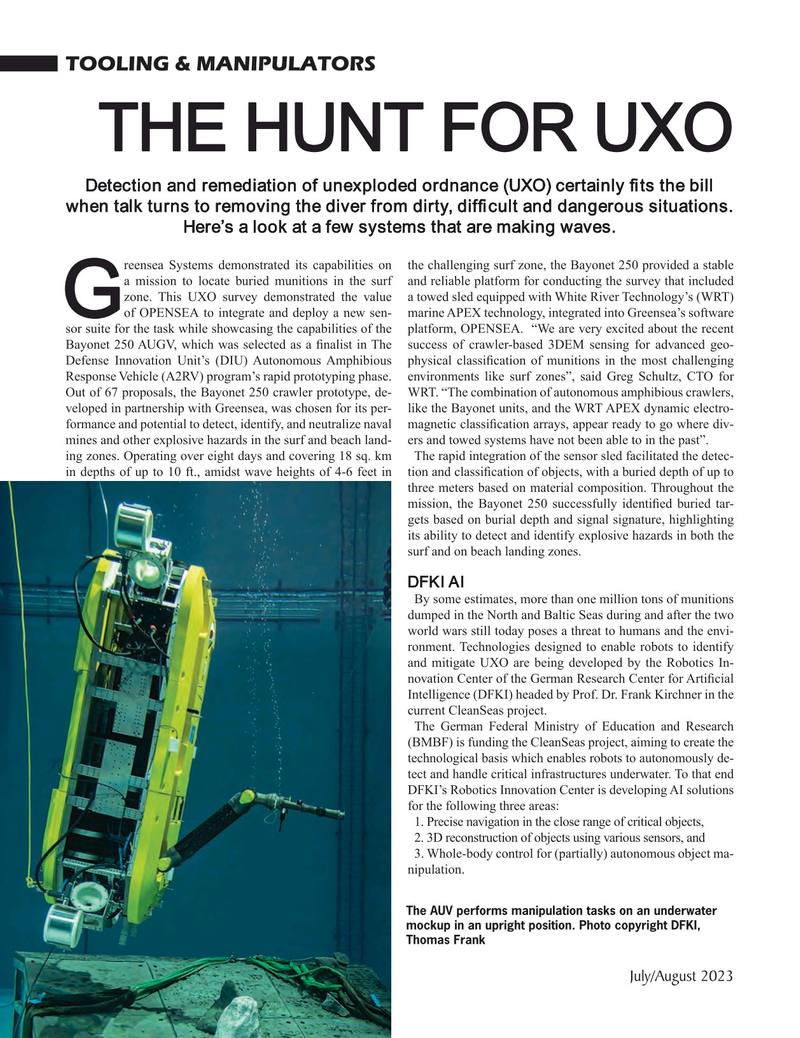
Page 32: of Marine Technology Magazine (July 2023)
Read this page in Pdf, Flash or Html5 edition of July 2023 Marine Technology Magazine
TOOLING & MANIPULATORS
THE HUNT FOR UXO
Detection and remediation of unexploded ordnance (UXO) certainly ? ts the bill when talk turns to removing the diver from dirty, dif? cult and dangerous situations.
Here’s a look at a few systems that are making waves.
reensea Systems demonstrated its capabilities on the challenging surf zone, the Bayonet 250 provided a stable a mission to locate buried munitions in the surf and reliable platform for conducting the survey that included zone. This UXO survey demonstrated the value a towed sled equipped with White River Technology’s (WRT)
Gof OPENSEA to integrate and deploy a new sen- marine APEX technology, integrated into Greensea’s software sor suite for the task while showcasing the capabilities of the platform, OPENSEA. “We are very excited about the recent
Bayonet 250 AUGV, which was selected as a ? nalist in The success of crawler-based 3DEM sensing for advanced geo-
Defense Innovation Unit’s (DIU) Autonomous Amphibious physical classi? cation of munitions in the most challenging
Response Vehicle (A2RV) program’s rapid prototyping phase. environments like surf zones”, said Greg Schultz, CTO for
Out of 67 proposals, the Bayonet 250 crawler prototype, de- WRT. “The combination of autonomous amphibious crawlers, veloped in partnership with Greensea, was chosen for its per- like the Bayonet units, and the WRT APEX dynamic electro- formance and potential to detect, identify, and neutralize naval magnetic classi? cation arrays, appear ready to go where div- mines and other explosive hazards in the surf and beach land- ers and towed systems have not been able to in the past”.
ing zones. Operating over eight days and covering 18 sq. km The rapid integration of the sensor sled facilitated the detec- in depths of up to 10 ft., amidst wave heights of 4-6 feet in tion and classi? cation of objects, with a buried depth of up to three meters based on material composition. Throughout the mission, the Bayonet 250 successfully identi? ed buried tar- gets based on burial depth and signal signature, highlighting its ability to detect and identify explosive hazards in both the surf and on beach landing zones.
DFKI AI
By some estimates, more than one million tons of munitions dumped in the North and Baltic Seas during and after the two world wars still today poses a threat to humans and the envi- ronment. Technologies designed to enable robots to identify and mitigate UXO are being developed by the Robotics In- novation Center of the German Research Center for Arti? cial
Intelligence (DFKI) headed by Prof. Dr. Frank Kirchner in the current CleanSeas project.
The German Federal Ministry of Education and Research (BMBF) is funding the CleanSeas project, aiming to create the technological basis which enables robots to autonomously de- tect and handle critical infrastructures underwater. To that end
DFKI’s Robotics Innovation Center is developing AI solutions for the following three areas: 1. Precise navigation in the close range of critical objects, 2. 3D reconstruction of objects using various sensors, and 3. Whole-body control for (partially) autonomous object ma- nipulation.
The AUV performs manipulation tasks on an underwater mockup in an upright position. Photo copyright DFKI,
Thomas Frank
July/August 2023
MTR #5 (18-33).indd 32 7/21/2023 9:13:57 AM

 31
31

 33
33
